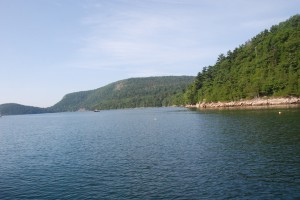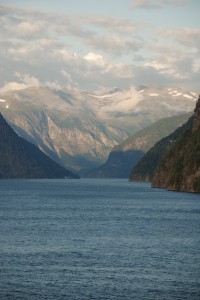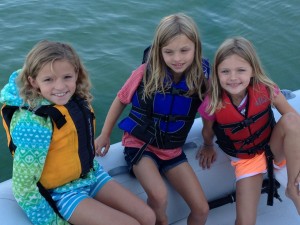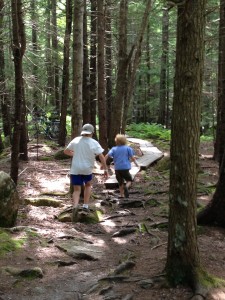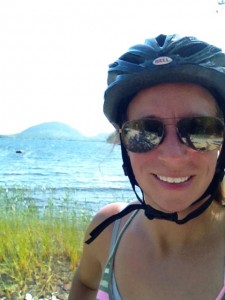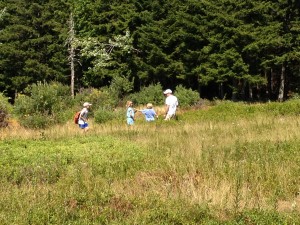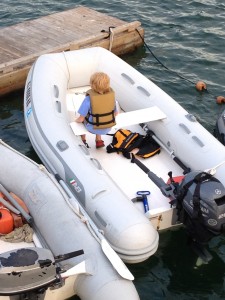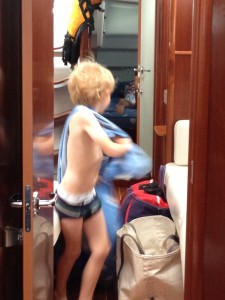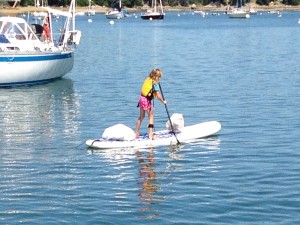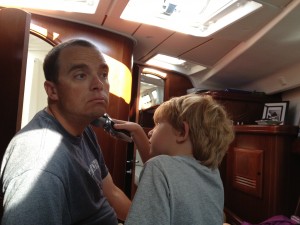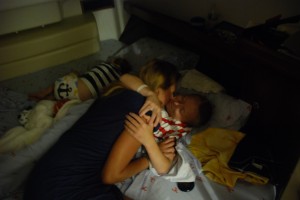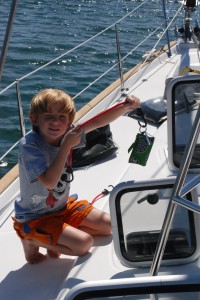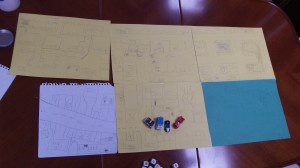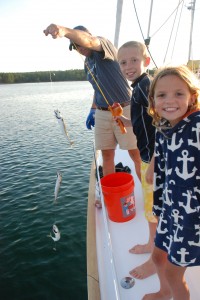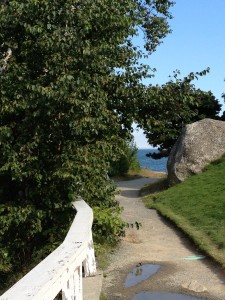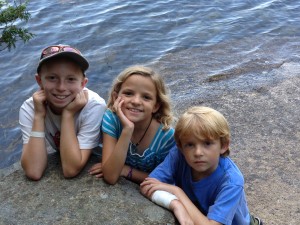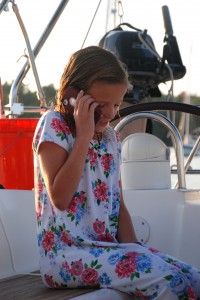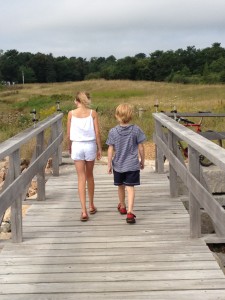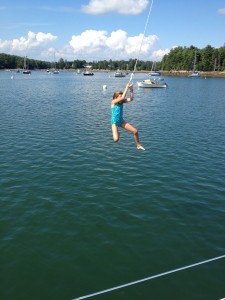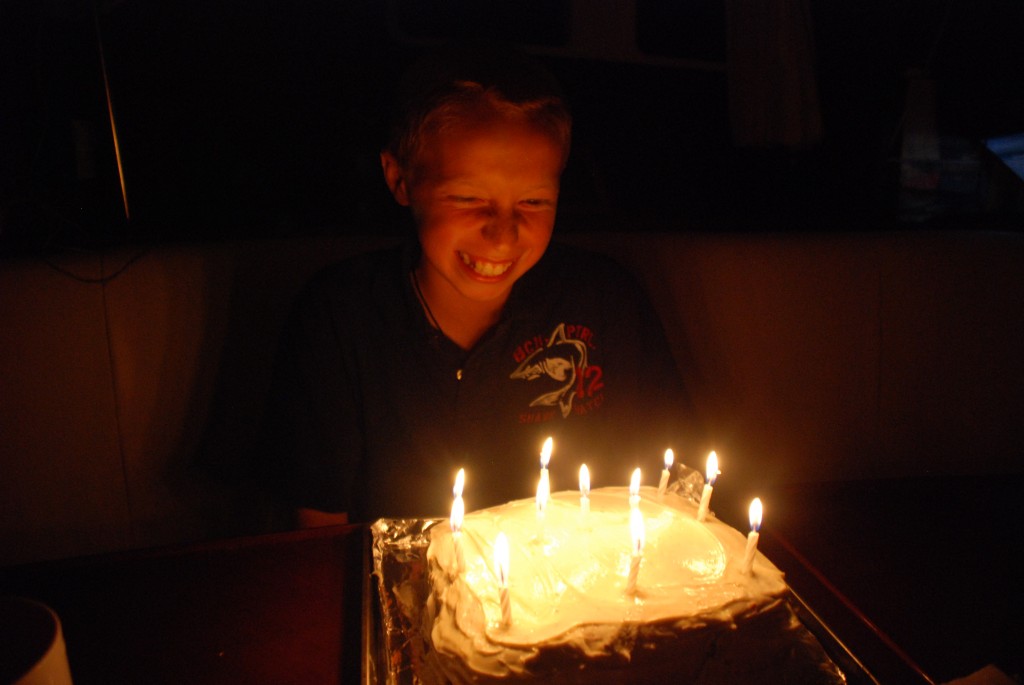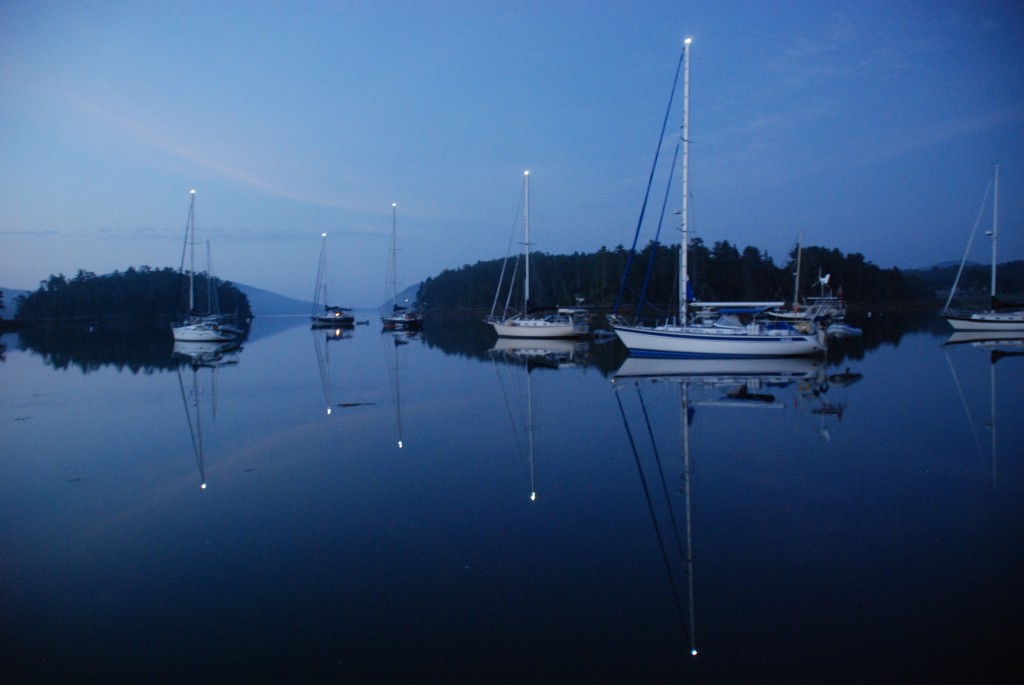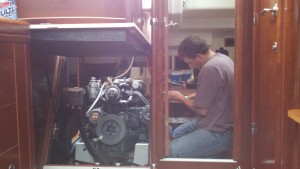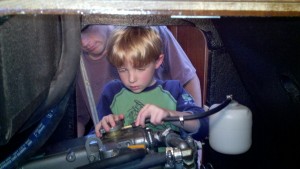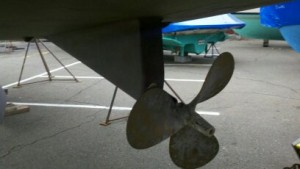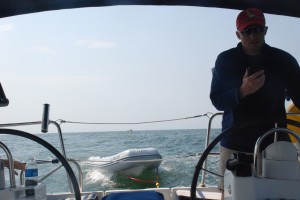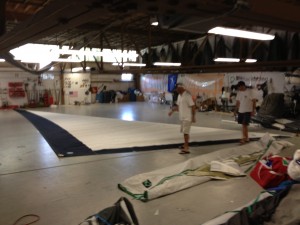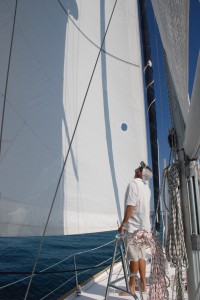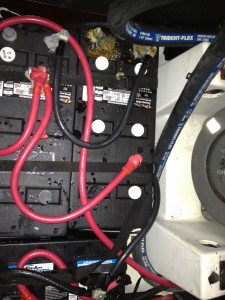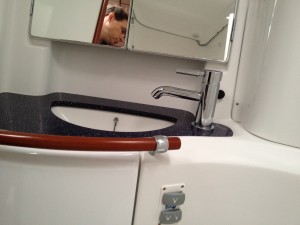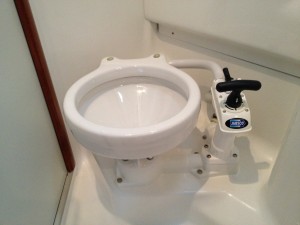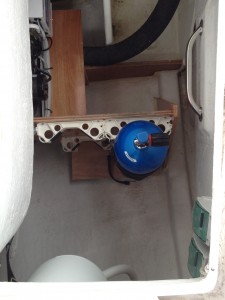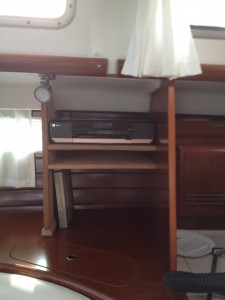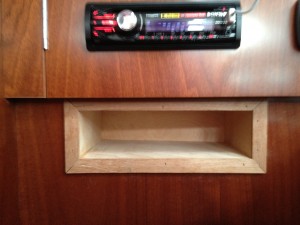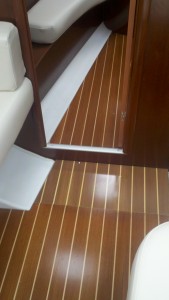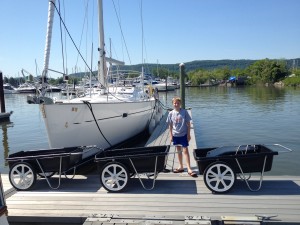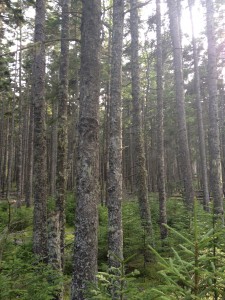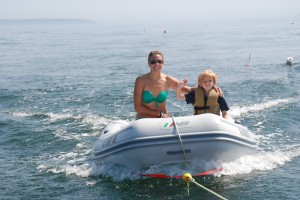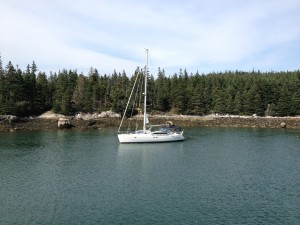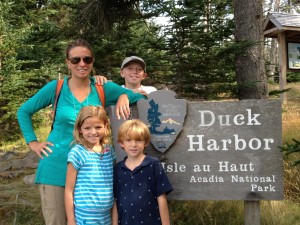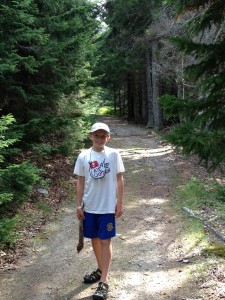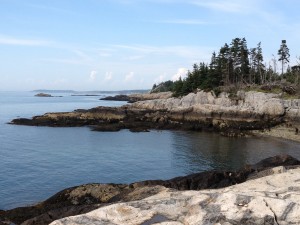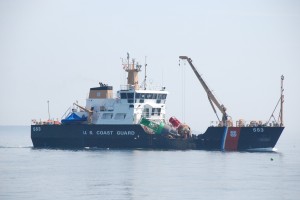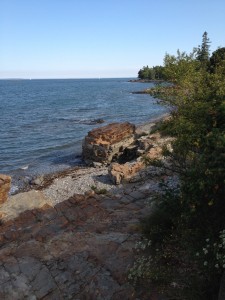 Mt. Desert Island, Maine/Acadia National Park
Mt. Desert Island, Maine/Acadia National Park
August 7-16, 2012 (not nearly enough time, though it might take you 10 days to get through this post)
Somes Harbor
We made it to Acadia National Park!! Really, anything but fly-infested Frenchboro would have been a hit with me, but we had our hopes very high for Acadia National Park and were duly impressed. As with many new places, it wasn’t quite what I expected and the surprises were what made it such a wonderful experience. What made it even better was my new cruiser attitude, which took a departure from my old way of planning, researching, and creating an agenda for each moment of the experience. We just showed up, ready to see what would happen…(I know. Those who know me well are falling off their desk chairs.)
Acadia National Park is spread over a lot of land in this area, but much of it is located on Mt. Desert Island, which is where Bar Harbor is located. The island is almost cut in two by a long, narrow fjord. It is the only fjord on the east coast of the United States. The guidebooks fairly gushed over the “steep dramatic cliffs” that “fall right into the sea”, but Chris and I spent our 10th anniversary on a cruise of the Norwegian Fjords. This was NOT a fjord. I can tell you that. It might have some sort of technical qualifications that make it one geologically, but I kept asking Chris when the fjord-y part was going to start, and suddenly we were at the end.
Nevertheless, we traversed the fjord and ended up in Somes Harbor, a gorgeous place with a surprising amount of boats. We found a place to anchor and took a look around. There was a small dinghy dock on the left bank and a small cove off to the right. There was a large rock in the cove and children were jumping off of it into the water. We came to see the national park system, but I was content to stay right there and swim, paddle, kayak, and hang out.
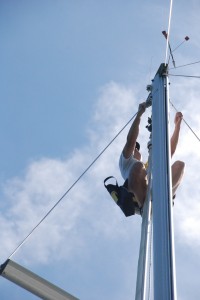 In fact, we had been on the move for so long that we decided to lay low the next day and enjoy the beauty around us. Chris and I worked on the boat and the kids worked on their independence. All three of them took the kayak and paddleboard and went over to the little cove, which is part of the Acadia campgrounds. They played with the kids there all day, jumping off the rock and crabbing. It was strange to allow them such freedom, but they felt comfortable with it, we could see them from the boat, and we took the dinghy over to check on them from time to time. They were so busy and happy that they didn’t want to come back for lunch!
In fact, we had been on the move for so long that we decided to lay low the next day and enjoy the beauty around us. Chris and I worked on the boat and the kids worked on their independence. All three of them took the kayak and paddleboard and went over to the little cove, which is part of the Acadia campgrounds. They played with the kids there all day, jumping off the rock and crabbing. It was strange to allow them such freedom, but they felt comfortable with it, we could see them from the boat, and we took the dinghy over to check on them from time to time. They were so busy and happy that they didn’t want to come back for lunch!
I worked on polishing the metal on the boat, starting with the barbeque. I cleaned down below (inside the boat) in between to rest my arms and jumped in the water for a refreshing swim when I got warm from all the work. When I was finished, I gave myself a manicure and pedicure. It was satisfying to get so much accomplished and a special treat to take care of my hard-working fingers and toes.
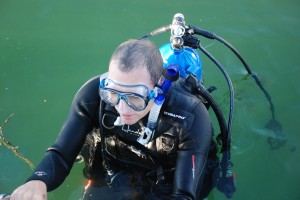 Chris replaced the zincs by suiting up with his SCUBA gear and diving under the boat with all kinds of tools. It was a successful first underwater job. Then he climbed to the top of the mast to run a halyard for a second jib. A halyard is the line (rope) that runs through the center of the mast and hauls things up- usually sails, but sometimes flags and sometimes people!
Chris replaced the zincs by suiting up with his SCUBA gear and diving under the boat with all kinds of tools. It was a successful first underwater job. Then he climbed to the top of the mast to run a halyard for a second jib. A halyard is the line (rope) that runs through the center of the mast and hauls things up- usually sails, but sometimes flags and sometimes people!
A catamaran anchored next to us and I noticed two young girls on board. When the kids returned from the campgrounds, they paddled over, introduced themselves to Emma and Katie, and ended up playing on their boat all afternoon. I started to think that maybe we wouldn’t go crazy having the kids 24/7/365. We’d barely seen them all day!
In the meantime, Mark and Julie from a nearby boat, Rachel, dinghied over to say hello. They provided a good stopping point for all the work we were doing and we ended up chatting for close to an hour. We enjoyed talking to them and tried not to pepper them with too many questions about living aboard, which they have been doing for five years.
We went over to the catamaran, Top Cat, to collect the kids, and ended up staying to chat for another hour! It was great to meet Janet and Michael Worthington and their uncle, Captain Michael Costello. The kids were all playing nicely. Their girls taught our kids a game called Bums, with a President, a Vice President, and a “Bum”. It took me a few rounds to realize what game it REALLY was. Oh, those college years of playing cards…
We went back to the boat and grilled filet mignon on our barbeque that is now shiny enough to be used as our mirror, and made tapioca for dinner. Unfortunately, the almost perfect day was punctuated when Porter hit his arm against the barbeque and got a 2-inch second degree burn. I just hope it wasn’t because he was so mesmerized with the shininess…
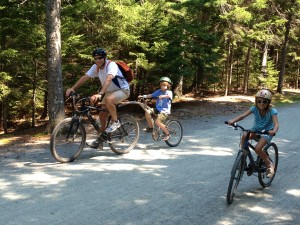 The next day, we took the free shuttle service into Bar Harbor and rented bicycles. The bike rental place (Acadia Bike) really had their act together. We were out of there with 4 bikes, one tagalong, 5 helmets, and a map in less than ten minutes. The park service has a special bus just for cyclists. You get on the bus and they toss your bike onto a huge rack that is towed behind. They took us right to the trailhead and off we went.
The next day, we took the free shuttle service into Bar Harbor and rented bicycles. The bike rental place (Acadia Bike) really had their act together. We were out of there with 4 bikes, one tagalong, 5 helmets, and a map in less than ten minutes. The park service has a special bus just for cyclists. You get on the bus and they toss your bike onto a huge rack that is towed behind. They took us right to the trailhead and off we went.
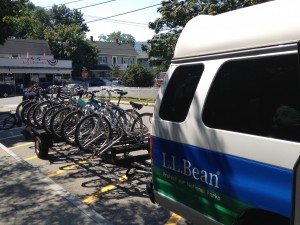 The Rockefellers, who owned much of the land in the area, created an intricate and extensive system of carriage roads throughout the area. The roads are about the width of a one lane road and are made of packed dirt with loose gravel. It was a great riding surface, providing a crunchy, pleasing sound as the tires rolled along them.
The Rockefellers, who owned much of the land in the area, created an intricate and extensive system of carriage roads throughout the area. The roads are about the width of a one lane road and are made of packed dirt with loose gravel. It was a great riding surface, providing a crunchy, pleasing sound as the tires rolled along them.
As usual, the kids did a great job keeping up, but it was a long ride with a lot of hills. I hadn’t been on a bike since Newport, so my legs were itching to goooooooo. I restrained myself for the most part, but I had to let it out on the downhills. After a while, Reese had had it and we found the Jordan Pond just in time. We had a picnic on the lake, but this was “the” spot to go to, so it was crawling with people. I had pictured my first national park experience to be an almost solitary one, communing with nature on deserted trails and taking crazy-amazing photos. Instead, I found myself sidestepping slow-moving tour-bus folks who were heading for the souvenir stand and the restaurant that served popovers for $12 a pop…
So we got out of there and headed back down the mountain. The carriage roads were quiet and almost empty since most people take the bus up to Jordan Pond. I got a real treat at the end when Chris agreed to ride down the short way with the kids while I took the longer route by myself. I took off like a 10-year-old and almost “whooped”. I got in some uphills and practiced downhilling on gravel, which was (almost) scary with all the hairpin turns. It takes a lot to convince me to touch the brakes going downhill, but I actually hit them a few times. My cycling friends will know how much that killed me.
I met back up with Chris and the kids, where they were picking wild blueberries and checking out a HUGE beaver dam. This is the Acadia I was looking for. At this point, I decided to throw out the guidebook, filled with “must-sees” and “must-dos” (which 9.6 million people were probably doing that very second) and just do our own thing…
When we got back to Bar Harbor, we bought Porter new Keens at one of the many outdoor outfitters in town and had well-deserved ice cream cones while waiting for the bus back to Somes Harbor. We took showers at the campground, paying $1.00 for 5 minutes of hot water. Seriously? I would have paid ten dollars to take a nice, long shower at that point, but five minutes was about all I could stand in the “rustic” shower cabin. On the short walk back to the dock through the woods, the mosquitoes managed to find me. I will sum up my thoughts on camping in one word. Never. (for more details, see my post on Frenchboro and what happens when Erica spends lots of time in the woods.)
We were really settling into Somes Harbor at this point. The next day, we took the bus the other way to Southwest Harbor. I did laundry at a great little Laundromat (with a crazy powerful WiFi hotspot!!!!) while Chris and the kids went to the Gilley Museum (a fascinating tribute to a plumber-turned-woodcarver with a dramatic family history). We had lunch in town, took a walk around the harbor, saw a blue lobster (only 1 in 2,000,000 lobsters is blue), and went back to the boat carrying 4 hugs sacks of laundry and a bag of live lobsters for dinner.
I went swimming, which brought on several surprised comments from nearby boats as I passed them. Mt. Desert Island is pretty far north, folks, and the water was getting colder and colder! While I was in the water, I cleaned the dinghy and the waterline of Patronus, trying very hard not to breathe in the scummy, dirty water as I cleaned. The kids and I worked on their reading logs in between making up the beds with clean sheets and giving the cabins a deep cleaning. Another dinghy visit with Mark and Julie from Rachel and it was really starting to feel like home…
Northeast Harbor
Alas, our heads were full (not those heads! The toilets!) and needed to be pumped out. We were also on our last tank of water. So after a morning of drawing, reading, math workbooks, and completely reorganizing the food storage (can you guess which of us did what?), we pulled anchor at 0940 and set down the “fjord”, which was just as un-fjord-y as the way up. But it was foggy, which was cool.
We pulled into Northeast Harbor, which is on the Southeast corner of Mt. Desert Island (anyone have an explanation for that one?), and waited an hour for a spot at the fuel dock to get diesel, water, and a pumpout at Clifton Dock. The people there were great, though, and their facilities were modern and very clean. We had a great time chatting it up with a few people there while waiting for the water tanks to fill up. One couple has cruised the Chesapeake for years and gave us tips on places to visit. We then continued on to the end of the harbor, where we had reserved a mooring with the town marina. They had an interesting setup. For $40 a night, we tied up to a little floating dock, which was moored out in the harbor. I have only seen this setup before in Camden. It was very cute.
We walked to town for a great lunch at a restaurant/bakery, did some shopping, and checked out the Maritime Museum. Back at the marina, I nearly dropped to my knees when I saw how big and clean the showers were. Put it this way. They were in a building called the “Yachtsman’s Center”. Not a buggy shack with a slot for quarters. Is it possible to be a public shower diva? Well print me up a t-shirt, because I took such a long shower that my skin was red for three hours and I was as happy as a clam.
I pulled out my computer to see if this marina was good enough to marry. Their WiFi was so strong that I immediately started uploading pictures as fast as I could. My website subscribers got a double dose of posts that night.
We set the clock for 0232, as we do every year on the eve of August 12th. Our little baby boy was turning eleven years old and we always wake him at the moment of his birth to wish him a happy birthday and quietly give thanks for his precious life. As always, I held him, gave him a kiss, and with my eyes closed, I remembered exactly how his warm, moist skin felt under my hands the very first time I held him. I remember realizing that I didn’t “have a baby”. I helped to create a human being, who was going to be his own person and make a difference in the world. I opened my eyes and saw my eleven-year-old, with his long legs, his almost-man-feet, his huge toothy grin, and his pirate pajamas. I felt the precipice on which he was standing, half way between boy and man, and I was so proud of him; so glad that I get to stand alongside him as he grows up.
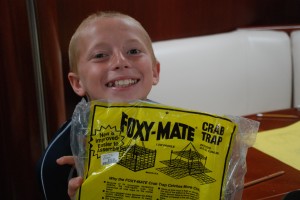 In the morning, an excited Porter snuck into our room to tell us that Bryson had not yet woken up. Luck strikes again! Bryson is our early bird and every year his early-rising threatens to break our tradition of waking the birthday person by sneaking into their room with cameras, video-recorders, and cake, singing “Happy Birthday To You” (this is never a problem on Reese’s birthday!) We woke him up, had breakfast, and gave Bryson his first birthday gift- a crab trap. The kids went right to work, crabbing right off our floating dock. They spent the morning fishing, blowing bubbles, and playing.
In the morning, an excited Porter snuck into our room to tell us that Bryson had not yet woken up. Luck strikes again! Bryson is our early bird and every year his early-rising threatens to break our tradition of waking the birthday person by sneaking into their room with cameras, video-recorders, and cake, singing “Happy Birthday To You” (this is never a problem on Reese’s birthday!) We woke him up, had breakfast, and gave Bryson his first birthday gift- a crab trap. The kids went right to work, crabbing right off our floating dock. They spent the morning fishing, blowing bubbles, and playing.
 When we had asked Bryson what he wanted to do for his birthday, he said he wanted to be in Somes Harbor, jumping off the rocks at the campground. We had to save that for the next day, because the weather was not good enough to travel back up to Somes. In the meantime, his other wish was to go into Bar Harbor and get pizza for dinner. So we took the shuttle into town, had some great pizza, and walked around while it drizzled on and off the rest of the afternoon. I’m sure it’s just a given at this point, but we also got ice cream.
When we had asked Bryson what he wanted to do for his birthday, he said he wanted to be in Somes Harbor, jumping off the rocks at the campground. We had to save that for the next day, because the weather was not good enough to travel back up to Somes. In the meantime, his other wish was to go into Bar Harbor and get pizza for dinner. So we took the shuttle into town, had some great pizza, and walked around while it drizzled on and off the rest of the afternoon. I’m sure it’s just a given at this point, but we also got ice cream.
Back at Patronus, Bryson enjoyed his phone calls and text messages with well-wishes, his birthday cards and presents. We had cake from our little oven and Bryson’s birthday was a definite success. Good thing, because we had big shoes to fill. His tenth birthday last year was spent on Block Island, and was one of those absolutely perfect days that only gets better and better every time you remember it.
The day was not over for me, however. We were headed back to Somes Harbor the next morning, which meant the end of my internet capability. I worked for six hours without moving, but at 0230 I went to sleep with all my posts written up through Bar Harbor, with pictures inserted, edited, and ready to publish. I have to say I’m starting to feel like a writer, instead of an aspiring one. I love the hours of writing, when I allow my thoughts to form in a stream of consciousness. When I give myself over to the process and stay in the present moment, I can feel the right words forming somewhere between my brain and my fingertips. When I go back to the stories written in that mindset, I usually don’t do much editing because that writing sounds so authentic.
Somes Harbor, Part Two
After touring Asticou Gardens (which was beautiful, but you’ve got to be tired of reading about every last thing we did here, so I’m wrapping it up), we headed back to Somes Harbor for Bryson’s day of 11-year-old fun. We enjoyed one more day and night back at Somes Harbor and really took a look around at what had turned out to be one of our favorite spots so far. We had spent most of our time here exploring Mt. Desert Island’s harbors, shores, and towns. We did not spend as much time as I expected in the actual “park”. If the kids were older, I’m sure we could have spent days hiking the challenging and deserted trails. But we were completely content to enjoy the beauty of the island from our little spot at the end of the, ahem, “fjord”.
At one point during the 9 days we were on Mt. Desert Island, I had to take the dinghy around the peninsula to a little marina to get ice. On the way back, I admired the beautiful boats in the harbor, watched the ducks floating on the waves, looked at the tall, slender spruce trees on land, and imagined living in one of the quaint little cottages dotted along the shore. I noticed how much I enjoyed the island from the vantage point of the water. I imagined how different it would be to spend the week viewing the island and the surrounding water from the shores, looking out. Later, I posed the following question to a friend. Which would you choose: to look at the ocean from the land, or look at the land from the ocean? Which would you choose, and why?
Our time in Mt. Desert Island was full of incredible experiences and images. Please take a moment to check out these videos and extra photos! -erica
Reese Swinging off the halyard
http://www.youtube.com/watch?v=INF3JUkcO-U
Bryson’s Birthday Morning
http://www.youtube.com/watch?v=j03pJmLvQcE&feature=youtu.be
Porter Tries on Shoes
http://www.youtube.com/watch?v=OfdgHKeP2_w&feature=youtu.be

